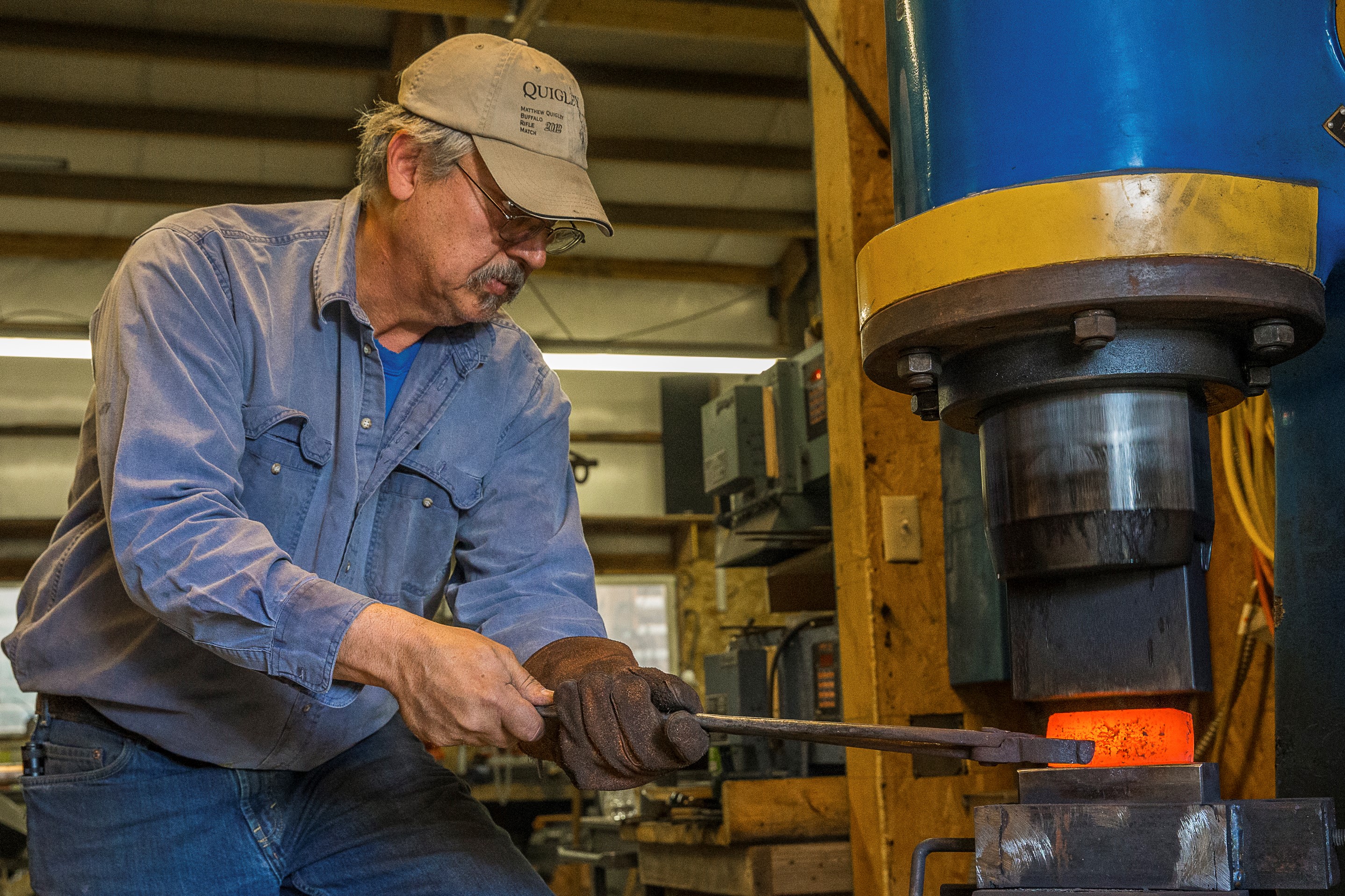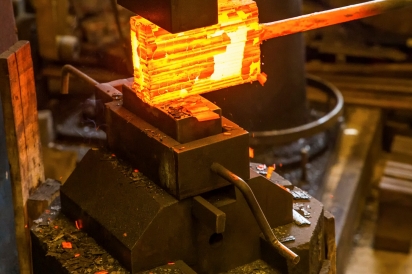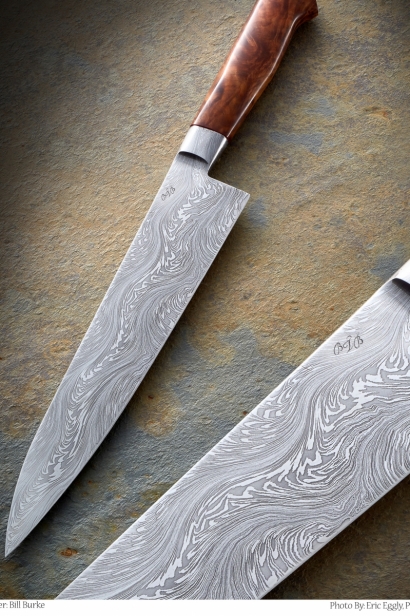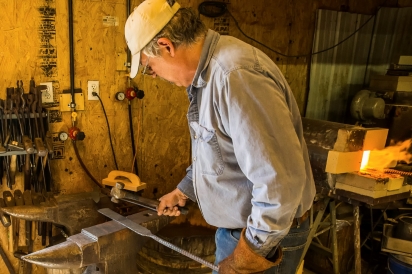MASTER OF STEEL BILL BURKE HONES A CENTURIES-OLD CRAFT NEAR IDAHO CITY
Unlike Longfellow’s poem about the village blacksmith, there is no spreading chestnut tree at Bill Burke’s shop. The roar of a propane forge replaces the whoosh of bellows; the thud and shudder of a power hammer replaces the clang of sledge on steel. But between strokes, the echo of hammer blows ring down the centuries as Burke practices his ancient craft, striving for stronger and sharper blades.
Working in his shop near Idaho City, Burke, 56, wears wirerimmed glasses between a mop of graying hair and a bushy woodsman moustache. He resembles the handy brother-in-law you call when the water heater goes out.
Burke’s knives start with a stack of alternating bright-and-dark steel bars. He heats, hammers, cuts and re-stacks the steel until it contains thousands, or hundreds of thousands, of increasingly thin layers. At certain times, he bends, folds or twists the heated steel just so to create one of his signature patterns in the finished knife. The contrasting steel layers create a strong blade that keeps a sharp edge and a bright-and-dark swirling pattern, indicative of his “Damascus” steel knives.
Burke finishes each knife by shaping the blade, hardening and tempering it, and crafting a handle. Wooden handles range from those with dramatic grain patterns to more subtle bog oak, buried in acid peat fens for thousands of years. Handles from animal products include fossilized mammoth ivory, or horns from musk ox or certain breeds of sheep.
The name “Damascus” steel conjures swords forged in what is now Syria and used against invading Europeans almost a millennium ago. Modern researchers found that the strength of those fearsome weapons came from carbon nanotubes in the steel. During heating and cooling
cycles as the steel was prepared, impurities in the ore, derived from a long-depleted ancient mine, allowed these nanotubes to form. Longago
artisans had never heard of nanotubes; they just kept working to make better and stronger steel. The wavy bright and dark patterns in Damascus blades were visible testament to the steel’s unique composition and production.
Although Burke’s knives are called “Damascus” steel, he uses different steels and different techniques to forge his blades. His knives are sharp and strong and similar patterns dance across his blades, but a more precise term for the process Burke uses is “pattern welded steel.” This technique has been used by innumerable cultures for centuries to forge strong steel for weapons and tools.
The American Bladesmith Society keeps alive the art and craft of hand-forging blades and certifies Journeyman and Master Bladesmiths. There are fewer than 120 Masters in the world and Burke is the only one in Idaho.
Burke’s journey to Master Bladesmith started in Salmon, a town named for an anadromous fish, where, “Didja get your elk yet?” is a common fall greeting. Growing up, Burke hunted and fished the mountains and rivers of central Idaho. He found that the knives he used, “just wouldn’t do what I wanted them to do. They wouldn’t hold an edge for a reasonable amount of time, or they were difficult to sharpen.” He was so disappointed by the knives he bought he tried making some himself.
After high school, Burke worked a variety of skilled jobs around Idaho: butcher, millwright, welder, front end and brake mechanic. As a millwright, he kept saws sharp and machinery humming at the sawmill in Salmon. As his metalworking skills developed at work, the knives he made at home got better, too. He figured some things out by himself and learned more from older masters. Burke pushed himself to make knives that would meet his standards.
When the sawmill closed, Burke went back to working on cars. He pulled clutches and brake pads off the shelves at an auto parts store during the day and “made knives from 6:30pm to 1 or 2 in the morning.” One knife saved two lives and changed Bill’s.
Two thousand miles away in the state of Georgia, a tornado picked up a truck and wedged it upside down beneath debris, trapping two people inside. The less seriously injured driver found the larger of two knives in the cab and started cutting his way out. The knife snapped. The other blade was one of Burke’s small hunting knives. The driver carved an escape hatch through layers of twisted metal using this knife and the men crawled out of the wreckage
The tornado story appeared in Blade magazine a few months before Burke took 27 knives to a 2003 blade show. In a few hours, he was out of knives and taking orders for more. Burke became a full-time knife maker the following year.
By the time the jaws-of-life knife freed Burke from the auto parts counter, he was making more kitchen and fewer hunting knives. In 2002, he was one of only a handful of kitchen knife makers at a show in Napa Valley, California. “Now,” Burke said, “everyone and their brother make what they claim are custom kitchen knives, but only a few are correctly made.”
Daniel O’Malley sells knives from around the world through his website and Epicurean Edge gallery in Kirkland, Washington, where Burke’s kitchen knives sell for about $1,500 apiece. He met Burke early in his knifemaking career and saw a different kind of craftsman. “Bill’s drive for a better knife … set him apart,” said O’Malley. “A well-designed knife becomes an extension of your hand … which can make cooking much more enjoyable.”
Farther south on Interstate 5, Taro Kobayashi begins prepping for work. As sushi chef at Mame, his Eugene, Oregon, restaurant, he knows knives. He works up to 13 hours a day and has a knife in his hand for 12. Altogether, he has 80 kitchen knives; his favorite was made nearly 500 miles away by Bill Burke.









